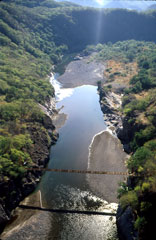Arriving at Chihuahua City

The following story was submitted to us by Kay Gilliland who describes her experience traveling with friends through Mexico’s Copper Canyon during the Christmas holidays. Today, Kay and her friends journey from Creel to Chihuahua City and learn more about the birthplace of the Mexican Revolution.
The California Native is always thrilled to have groups of friends join our trips to this charming region of Mexico. We appreciate it when our guests share their stories with us and we like to add them to our blog for everyone to enjoy. Excerpts from her journal will be posted regularly, so check back often to learn more about Kay’s 11-day Copper Canyon Adventure.
January 1, 2009, Thursday, New Year’s Day
Breakfast was delicious with juice, fruit (papaya, watermelon and, for the first time, apple), eggs, beans and a cinnamon drink called “café.”
We said goodbye to Sol and climbed into our vehicle. Antonio headed out onto “Ruta 2010” named in honor of the succeeding hundred-year events in Mexican history. Jessica pointed out the major change in our surroundings; we were traversing the chaparo: wheat fields, cattle, large land holdings. We stopped at Ahumada and again at La Posta for snacks and el baño. Jenny bought dolce de leche to share with us. We passed a place where lead and zinc ore from Urique is processed. We drove into a Mennonite town looking for “Campo 2B, Casa 46.” The houses were well-built and prosperous-looking but drab in color by comparison to houses we had been seeing in Batopilas, Creel and San Juanito. Jessica described the Mennonites as industrious and homespun, who made everything themselves, especially foods—cheese, butter, bread, jam—and clothing, potholders, and tablecloths. We stopped at the home of Lisa (I asked for her last name but never got it), who had prepared coffee/tea, cookies, meat, cheese, jams and home-baked bread for us. Her sister Emma had just had a baby and Lisa showed us the camera with a picture. Everything tasted really good and Jessica noticed a type of cookie she had not seen before, so she commented that it was new and asked how Lisa made it. Lisa went into the kitchen and brought out a package of Duncan Hines mix to show us.
We walked around the Mennonite farm looking at the Chihuahua puppies, the goats, cows, pigs, geese and farm machinery. Lisa belongs to a family of Old Colony Mennonites who live in a more conservative way than some others of their group.
Back on the road we passed ocotillo, but not in bloom, and lots of apple orchards. We saw smudge pots and furled nets ready to combat frost and save the apple crops. The apple boxes we had seen at the lumberyard were also in readiness for this vast apple-growing operation. Even the local baseball team gets a piece of the action; they are the Manzaneros. Spring will bring a fragrant show of blossoms and fall will be bright with red apples, but we were driving through in winter.
Jessica gave us maps and told us the name Chihuahua is translated as “Sandy Place” or “Place Between Two Rivers.” The city of Chihuahua is the state capital of the Mexican state of Chihuahua. Here, our local guide, Jesus, spoke Spanish and Jessica did an admirable job of translating. For two hundred years Chihuahua was a place of wars between the Apaches and the Comanches. It was the place where Hidalgo, hero of the Mexican Revolution was imprisoned and executed in 1811. We stopped to see a palacial home, Quinta Manuel Gameros, built 1907-1910. The “Quinta” refers to the size of the property: 1/5 of a hectare. A hectare is almost 2.5 acres, so these homes were well situated.
We toured the Pancho Villa Museum and were especially interested in a powerful mural by Felipe Castellanos Centurión. Afterward we went into the Cathedral and then walked around the Plaza de Armas to the various booths set up to sell food and gifts. At one I finally saw the tire sandals for sale. Jessica bought Natas to share with us; they were delicious. Jesus pointed out the Dancing Fountains near the Palacio de Gobierno and we drove back to the Chihuahua City Holiday Inn Suites. California Native provided free Margaritas for us and we were given a ride to a delightful dinner in a very quiet newly-opened restaurant. Back at our lodging we were soon asleep.






